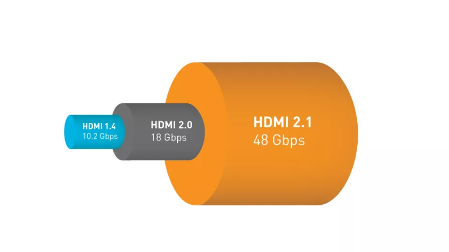CES 2018: CE Devices With Certified HDMI 2.1 Unlikely This Year, HDMI Forum Says
LAS VEGAS—The HDMI LA (Licensing Administrator) hopes to publish the first HDMI 2.1 compliance test specifications in Q2 and roll out the rest in phases through Q3 and Q4, but certified products aren’t likely to be on the market this year, HDMI Forum executives said during CES 2018.

Nonetheless, some 2018 CE products could be available later this year with some 2.1 features enabled but without having undergone certification testing for those features, said Robert Blanchard, president of the HDMI Forum, which develops HDMI specs. A number of features will be ready for certification testing by year’s end, he added.
Some 2.1 features, such as eARC, could be added to some current products as firmware updates, he added, and in fact Marantz plans to add eARC firmware updates to some of its current AVRs at an unspecified date.
Forum executives would not speculate on when the first CE products with certified HDMI 2.1 ports would be available to consumers. Forum chairman Chris Pasqualino said the forum is trying to publish the first phase of compliance-test requirements in the second quarter and hopes the requirements for all testing will be ready in the third quarter, though the final requirements might also come in the fourth quarter. In terms of text, the size of the spec doubled over its predecessor, so “there is a lot to test,” he said
The forum is “highly focused on compliance testing,” Blanchard added.
Finalization of the 2.1 specification was originally promised for the second quarter of 2017 but slipped into the fourth quarter. The original due date was a best estimate that slipped because the forum received more comments in the comment period than expected.
In its CES booth, HDMI LA is hosting demos of three pre-production AVRs with eARC, ultra-high-speed bandwidth, ultra-high-speed cable dynamic HDR, and other 2.1 features.
The HDMI 2.1 spec, released by the HDMI Forum in late 2017 and licensed by the HDMI LA, boosts data throughput to 48Gbps from 18Gbps, supports 8K video for TVs, 5K and 10K video for ultra-wide-format commercial displays and ultra-wide consumer TVs, higher frame rates to 120 fps at resolutions from 4K to 10K, and features native support for potential future active-metadata HDR technologies. Ultra High Speed HDMI cables supporting HDMI 2.1 will be backward compatible with ports incorporating earlier versions of HDMI.
New Ultra High Speed HDMI cables with 48Gbps bandwidth, up from 18Gbps for Premium cables, will be needed to pass through 8K and 10K resolutions and 5K resolutions at 48 fps and up. Some 4K video will also need the extra bandwidth, such as 4K video at 48 fps with 12-bit color depth and 4:4:4 chroma.
The new cable creates extremely low EMI (electro-magnetic interference) to reduce interference with nearby wireless devices, the forum said. The cable is backward-compatible for use with the installed base of HDMI devices.
HDMI 2.1 also widens the bandwidth of the Audio Return Channel (ARC) to 38Mbps from 1Mbps, leaving ample room for bandwidth-intensive audio formats to pass from a TV to HDMI-equipped AV receivers and sound bars. The new ARC, dubbed eARC for enhanced ARC, adds support for such audio formats as Dolby TrueHD and DTS HD Master Audio and up to eight channels of 192kHz/24-bit sound.
The new ARC also eliminates interoperability problems between brands by moving device discovery from HDMI CEC to a new eARC data channel.
Though HDMI 2.0 already supports at least two dynamic-metadata technologies -- Dolby Vision and HDR 10+, HDMI 2.1 added native support for potential future active-metadata HDR technologies, thanks to its extensibility, said HDMI Forum president Robert Blanchard.
Video streams requiring the new cable include 4K video with 10-bit color depth, 48-60 fps and 4:4:4 chroma; most variations of 5K video; and all variations of 8K and 10K video.
Many high-res video streams will pass uncompressed through new Ultra High Speed HDMI cables, but Display Stream Compression (DSC) will kick in to squeeze through some streams whose uncompressed signal exceeds 48Gbps. Examples include 5K with 10-bit color depth, 100-120 fps and 4:4:4 chroma; 8K with 10 bits, 48-60 fps, and 4:2:0 chroma; and 10K with 10 bits, 24-30 fps, and 4:4:4 chroma.
Other enhancements in HDMI 2.1 include:
- A variable refresh rate (VRR) to reduce or eliminate lag, stutter and frame tearing to deliver more fluid and better detailed gameplay.
- Quick media switching (QMS) for movies and video to eliminate blank screens before content is displayed.
- Quick frame transport (QFT) reduces latency for smoother no-lag gaming and real-time interactive virtual reality.
- And auto low latency mode (ALLM), which automatically sets the ideal latency for smooth, lag-free and uninterrupted viewing and interactivity.
This story first appeared on TVT's sister publication TWICE.
Get the TV Tech Newsletter
The professional video industry's #1 source for news, trends and product and tech information. Sign up below.
